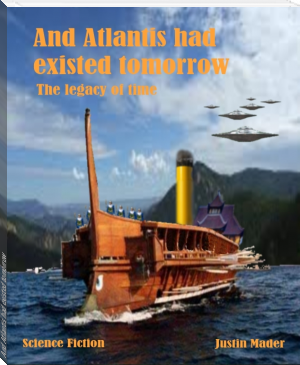Atlantis: The Antedeluvian World by Ignatius Donnelly (thriller novels to read .TXT) 📕

- Author: Ignatius Donnelly
- Performer: -
Book online «Atlantis: The Antedeluvian World by Ignatius Donnelly (thriller novels to read .TXT) 📕». Author Ignatius Donnelly
The Gulf of Santorin, in the Grecian Archipelago, has been for two thousand years a scene of active volcanic operations. Pliny informs us that in the year 186 B.C. the island of “Old Kaimeni,” or the Sacred Isle, was lifted up from the sea; and in A.D. 19 the island of “Thia”
(the Divine) made its appearance. In A.D. 1573 another island was created, called “the small sunburnt island.” In 1848 a volcanic convulsion of three months’ duration created a great shoal; an earthquake destroyed many houses in Thera, and the sulphur and hydrogen issuing from the sea killed 50 persons and 1000 domestic animals. A recent examination of these islands shows that the whole mass of Santorin has sunk, since its projection from the sea, over 1200 feet.
The fort and village of Sindree, on the eastern arm of the Indus, above Luckput, was submerged in 1819 by an earthquake, together with a tract of country 2000 square miles in extent.
“In 1828 Sir A. Burnes went in a boat to the ruins of Sindree, where a single remaining tower was seen in the midst of a wide expanse of sea.
The tops of the ruined walls still rose two or three feet above the level of the water; and, standing on one of these, he could behold nothing in the horizon but water, except in one direction, where a blue streak of land to the north indicated the Ullah Bund. This scene,” says Lyell (“Principles of Geology,” p. 462), “presents to the imagination a lively picture of the revolutions now in progress on the earth-a waste of waters where a few years before all was land, and the only land visible consisting of ground uplifted by a recent earthquake.”
We give from Lyell’s great work the following curious pictures of the appearance of the Fort of Sindree before and after the inundation.
FORT OF SINDEE, ON THE EASTERN BRANCH OF THE INDUS, BEFORE IT WAS SUBMERGED BY THE EARTHQUAKE OF 1819.In April, 1815, one of the most frightful eruptions recorded in history occurred in the province of Tomboro, in the island of Sumbawa, about two hundred miles from the eastern extremity of Java. It lasted from April 5th to July of that year; but was most violent on the 11th and 12th of July. The sound of the explosions was heard for nearly one thousand miles. Out of a population of 12,000, in the province of Tombora, only twenty-six individuals escaped. “Violent whirlwinds carried up men, horses, and cattle into the air, tore tip the largest trees by the roots, and covered the whole sea with floating timber.” (Raffles’s “History of Java,” vol. i., p. 28.) The ashes darkened the air; “the floating cinders to the westward of Sumatra formed, on the 12th of April, a mass two feet thick and several miles in extent, through which ships with difficulty forced their way.” The darkness in daytime was more profound than the blackest night. “The town called Tomboro, on the west side of Sumbawa, was overflowed by the sea, which encroached upon the shore, so that the water remained permanently eighteen feet deep in places where there was land before”. The area covered by the convulsion was 1000 English miles in circumference. “In the island of Amboyna, in the same month and year, the ground opened, threw out water and then closed again.” (Raffles’s “History of Java,” vol. i., p. 25.) VIEW OF THE FORT OF SINDREE FROM THE WEST IN MARCH, 1839.
But it is at that point of the European coast nearest to the site of Atlantis at Lisbon that the most tremendous earthquake of modern times has occurred. On the 1st of November, 1775, a sound of thunder was heard underground, and immediately afterward a violent shock threw down the greater part of the city. In six minutes 60,000 persons perished. A great concourse of people had collected for safety upon a new quay, built entirely of marble; but suddenly it sunk down with all the people on it, and not one of the dead bodies ever floated to the surface. A great number of small boats and vessels anchored near it, and, full of people, were swallowed up as in a whirlpool. No fragments of these wrecks ever rose again to the surface; the water where the quay went down is now 600 feet deep. The area covered by this earthquake was very great. Humboldt says that a portion of the earth’s surface, four times as great as the size of Europe, was simultaneously shaken. It extended from the Baltic to the West Indies, and from Canada to Algiers. At eight leagues from Morocco the ground opened and swallowed a village of 10,000
inhabitants, and closed again over them.
It is very probable that the centre of the convulsion was in the bed of the Atlantic, at or near the buried island of Atlantis, and that it was a successor of the great earth throe which, thousands of years before, had brought destruction upon that land.
ERUPTION OF VESUVIUS IN 1737.Ireland also lies near the axis of this great volcanic area, reaching from the Canaries to Iceland, and it has been many times in the past the seat of disturbance. The ancient annals contain numerous accounts of eruptions, preceded by volcanic action. In 1490, at the Ox Mountains, Sligo, one occurred by which one hundred persons and numbers of cattle were destroyed; and a volcanic eruption in May, 1788, on the hill of Knocklade, Antrim, poured a stream of lava sixty yards wide for thirty-nine hours, and destroyed the village of Ballyowen and all the inhabitants, save a man and his wife and two children. (“Amer. Cyclop.,”
art. Ireland.)
While we find Lisbon and Ireland, east of Atlantis, subjected to these great earthquake shocks, the West India Islands, west of the same centre, have been repeatedly visited in a similar manner. In 1692
Jamaica suffered from a violent earthquake. The earth opened, and great quantities of water were cast out; many people were swallowed up in these rents; the earth caught some of them by the middle and squeezed them to death; the heads of others only appeared above-ground. A tract of land near the town of Port Royal, about a thousand acres in extent, sunk down in less than one minute, and the sea immediately rolled in.
The Azore Islands are undoubtedly the peaks of the mountains of Atlantis. They are even yet the centre of great volcanic activity. They have suffered severely from eruptions and earthquakes. In 1808 a volcano rose suddenly in San Jorge to the height of 3500 feet, and burnt for six days, desolating the entire island. In 1811 a volcano rose from the sea, near San Miguel, creating an island 300 feet high, which was named Sambrina, but which soon sunk beneath the sea. Similar volcanic eruptions occurred in the Azores in 1691 and 1720.
Along a great line, a mighty fracture in the surface of the globe, stretching north and south through the Atlantic, we find a continuous series of active or extinct volcanoes. In Iceland we have Oerafa, Hecla, and Rauda Kamba; another in Pico, in the Azores; the peak of Teneriffe; Fogo, in one of the Cape de Verde Islands: while of extinct volcanoes we have several in Iceland, and two in Madeira; while Fernando de Noronha, the island of Ascension, St. Helena, and Tristan d’Acunha are all of volcanic origin. (“Cosmos,” vol. v., p. 331.) The following singular passage we quote entire from Lyell’s Principles of Geology,” p. 436:
“In the Nautical Magazine for 1835, p. 642, and for 1838, p. 361, and in the Comptes Rendus, April, 1838, accounts are given of a series of volcanic phenomena, earthquakes, troubled water, floating scoria, and columns of smoke, which have been observed at intervals since the middle of the last century, in a space of open sea between longitudes 20° and 22′ W., about half a degree south of the equator. These facts, says Mr.
Darwin, seem to show that an island or archipelago is in process of formation in the middle of the Atlantic. A line joining St. Helena and Ascension would, if prolonged, intersect this slowly nascent focus of volcanic action. Should land be eventually formed here, it will not be the first that has been produced by igneous action in this ocean since it was inhabited by the existing species of testacea. At Porto Praya, in St. Jago, one of the Azores, a horizontal, calcareous stratum occurs, containing shells of recent marine species, covered by a great sheet of basalt eighty feet thick. It would be difficult to estimate too highly the commercial and political importance which a group of islands might acquire if, in the next two or three thousand years, they should rise in mid-ocean between St. Helena and Ascension.”
These facts would seem to show that the great fires which destroyed Atlantis are still smouldering in the depths of the ocean; that the vast oscillations which carried Plato’s continent beneath the sea may again bring it, with all its buried treasures, to the light; and that even the wild imagination of Jules Verne, when he described Captain Nemo, in his diving armor, looking down upon the temples and towers of the lost island, lit by the fires of submarine volcanoes, had some groundwork of possibility to build upon.
But who will say, in the presence of all the facts here enumerated, that the submergence of Atlantis, in some great world-shaking cataclysm, is either impossible or improbable? As will be shown hereafter, when we come to discuss the Flood legends, every particular which has come down to us of the destruction of Atlantis has been duplicated in some of the accounts just given.
We conclude, therefore: 1. That it is proven beyond question, by geological evidence, that vast masses of land once existed in the region where Atlantis is located by Plato, and that therefore such an island must have existed; 2. That there is nothing improbable or impossible in the statement that it was destroyed suddenly by an earthquake “in one dreadful night and day.”
CHAPTER. V.
THE TESTIMONY OF THE SEA.
Suppose we were to find in mid-Atlantic, in front of the Mediterranean, in the neighborhood of the Azores, the remains of an immense island, sunk beneath the sea—one thousand miles in width, and two or three thousand miles long—would it not go far to confirm the statement of Plato that, “beyond the strait where you place the Pillars of Hercules, there was an island larger than Asia (Minor) and Libya combined,” called Atlantis? And suppose we found that the Azores were the mountain peaks of this drowned island, and were torn and rent by tremendous volcanic convulsions; while around them, descending into the sea, were found great strata of lava; and the whole face of the sunken land was covered for thousands of miles with volcanic





Comments (0)